
Glengarry and bonnet badge of the
Highland Light Infantry of Canada

Shoulder title of the
Highland Light Infantry of Canada

The Mackenzie Tartan of the
Highland Light Infantry of Canada

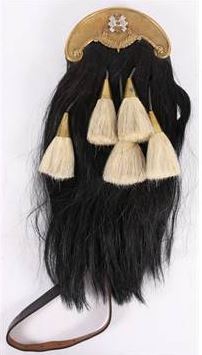
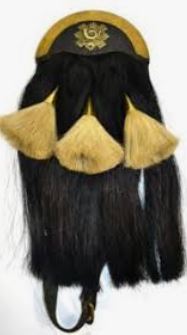
(See above) On
photographs of the
Highland Light Infantry
of Canada's Pipe band three different types of sporran can be
distinguished:
(From Left to Right) 2 black-tasseled White hair Sporran for the
Pipers, 5 white-tasseled Black hair Sporran for the Pipe Major,
and 3 white-tasseled Black hair sporran for the Pipe Sergeant.
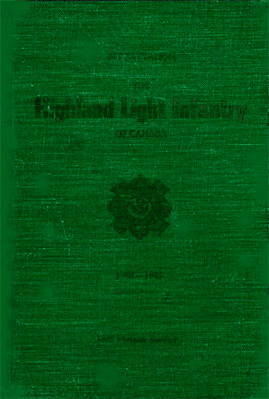
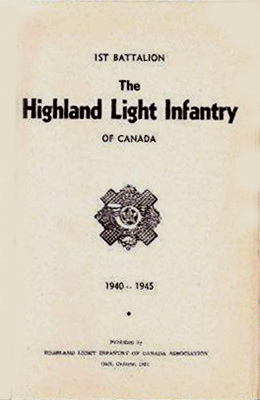
This is the Regimental History
Book of
the 1st. Battalion of The Highland Light Infantry of Canada,
from which quotes will be used below here, on this page,
with additions from "Proud Heritage, Vol4", the Regimental
history of the Sister regiment:
The "Imperial" Highland Light Infantry from Scotland
(See Illustration below)

(Above)
"Proud Heritage, Vol4", the Regimental history of the Sister
regiment:
The "Imperial" Highland Light Infantry from Scotland
The Highland Light Infantry
of Canada was allied to the Highland light Infantry (City of
Glasgow Regiment) of Scotland. They were initially kitted with
green glengarries, Mackenzie trews and a scarlet doublet, but
became kilted in 1935. Pipers and bandsmen in full dress wore a
feather bonnet with red hackle, Mackenzie hose tops for the pipers and red and
white for the regiment, and a blue balmoral bonnet with a diced
border, green tourie and a red and white hackle.

Source:
https://es-la.facebook.com/RHFCPD/photos/a.906156826093585/4305875302788370/?type=3&theater
H.L.I. of Canada Pipers and Drummers at Cove Field, Quebec City,
1941.
Left to Right: Bill Bowden A. L. Harris C.
Cole "Ducky Mollard" K. Mc.Lean Bill Smith A. Presswell
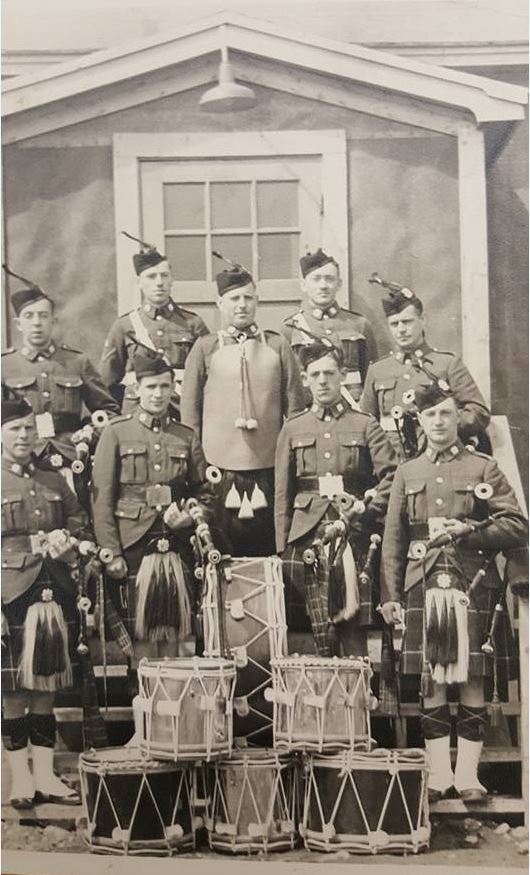
H.L.I. of Canada Pipes and Drums at Camp Debert (N.S), 1941.
Back:
W. Smith A. Presswell L. Livingstone D. Mc.
Cutcheon C. Walpole
Front: S. Corstorphine (P.M) A.L. Harris
K. Mc.Lean W. Melville
The following is quoted from the
aforementioned sources:
Defence not Defiance
Waterloo Region, Ontario, Canada, 1941
"Not in Canada in those early days was there need for
recruiting parades and posters, the blood stirring music of
bands, or frenetic speeches to rouse a false patriotism. The
word went out... 'the H.L.I. is mobilizing'... and the response
to the word was so overwhelming that mobilization was completed
quietly, efficiently, and with record-making speed... It was
mobilization of a citizen army, of men and youths who flocked to
the Colours, not with any false idea about the glamour of war,
but with a true ideal as their spur. They mobilized for defence,
not defiance. "
Many were already in the militia before The Regiment was ordered
to mobilize in May of 1940, while others flocked to the
recruiting drive afterwards, coming from such nearby communities
as Preston, Hespeler, Ayr and Breslau.
Although the city of Kitchener had its own militia regiment, The
Scots Fusiliers, they were yet to receive mobilization orders
from Ottawa, which meant that a flood of militiamen from the
Scots Fusiliers were requesting transfers to the nearby Highland
Light Infantry in Galt. This was no problem for the H.L.I.'s
recruiting office; their orders were to recruit enough to fill a
standard Canadian Active Service Force (C.A.S.F.) Battalion of no
less than 800 soldiers.
Once they had recruited over 1,000 volunteers, The First
Battalion of The Highland Light Infantry of Canada shipped out
to Stratford for basic training.
Shake out, then ship out
It was not until January P, 1941 that the First
Battalion shipped out of the province to join the gathering of
fledgling military personnel, as they moved off by train first
to Quebec City then Debert Camp, Nova Scotia. It was there they
became part of the new 3rd. Division, which was made up of nine
battalions exactly like them. For five months they soldiered,
then were given a final leave of three weeks before leaving for
Great Britain. By train the men of Waterloo County arrived back
home so that families and loved ones could be together. Sadly,
for many it would be the last time.

Troopship S.S. Strathmore
Troopship S.S. Strathmore
Gross Registered Tonnage - 23,428 tons
Length x Width - 665 feet x 82 feet
Builder and Year of Build - Vickers-Armstrongs of Barrow - 1935
First Class + Tourist Accommodation - 445 + 665 persons : Total
1,110 passengers
The Strathmore was
requisitioned for use as a troopship, as were all the 'Straths'
. She saw service in most theatres of war in a rather similar
manner to the Strathnaver and Strathaird. One of her many
voyages found her in March 1941 a member of a vast convoy to the
Middle East. There were 23 troopships in all, including all the
five 'Straths', the Viceroy of India, four orient liners and
ships of the Royal Mail, Cunard,Union castle, CPR together with
Dutch and French Liners. P & O were thus well presented.
Gourock, Scotland July 1941
As the S.S. Strathmore came into sight of Scotland,
soldiers filled the decks to watch the land slowly loom closer.
After a monotonous trip across the Atlantic, everyone was
anxious to touch solid ground, especially those who didn't
handle the churning of the ocean well. The port of Gourock had
always been a busy place for ocean going vessels. Since the war,
though, its traffic increased significantly.
Gently the ship coasted in the final yards for docking. On
shore, a gathering of curious Scottish folk watched the
Canadians arrive, and an army pipe and drums band began to play
while people on both the boat and the shore smiled across the
water. The band continued to play merrily as the men disembarked
from the Strathmore, onto Scottish soil. It was The Highland
Light Infantry (City of Glasgow) Regiment, their official sister
regiment; providing their overseas kin with a red carpet
welcome to Great Britain, and of course, the war. Over the time
spent training on the island, the officers of The City of
Glasgow Regiment would go out of their way to establish healthy
relations, Chuck Campbell recalled the gatherings:
"A lot of us didn't drink or smoke... this
surprised a lot of them, I remember one of them said, you call
yourselves highlanders?"
Bare Bones:
The anatomy of a 1941 infantry battalion
Like every Canadian unit to arrive in Britain, the
H.L.I of C was an essentially bare bones organization. They had
stepped off the SS Strathmore with little more than themselves,
some personal equipment, and a .303 Lee Enfield rifle. Before
they could serve in any useful capacity, they had to undergo the
metamorphosis from being a simple gathering of riflemen into a
modern infantry battalion.
Back at Debert Camp, the manoeuvres contained so many notional
factors and equipment that, in hindsight after years of training
in Britain, seemed like children's games: "... on this attack,
there would be mortars suppressing the enemy position ...you'd
have carriers to tow field guns up after consolidation ...
notional tank support... notional artillery support...”
All of the equipment they had been told of was about to become
an organic part of the H.L.I; the latest anti-tank guns, mortars,
heavy machineguns, tracked vehicles, trucks, and jeeps were just
a few of the items which transformed the simple gathering of
riflemen into a formidable fighting machine.
Qualifying courses were taught mainly by the British on how to
use every new item. For weeks or more at a time, soldiers and
officers alike would depart from the HLI’s lodgings to take
special training courses; after which platoons, each of which
were much larger than they would invariably become part of the
new the average rifle platoon of 36 men and each providing a
specific role: "Combat Support Company".


Left:
The H.L.I. of
Canada pipe band, with A. Corstorphine as Pipe major.
In the background one of the bikes used later for
the Normandy invasion.
(Photograph courtesy of H.L.I. veteran
Mr. A.L. Harris.) Right: Pipe Major Art Corstorphine,
relaxing with some H.L.I. of C. officers, in England.


Bognor Regis, Sussex 1942, the Pipes & Drums of the Highland
Light Infantry of Canada, 9th Bde. of the 3rd. Can. Inf. Div.
Billets at Bognor Regis November
1941-May 1942
Once equipped, the first task of the H.L.I. was to
defend the island of Great Britain from invasion. Most British
units by this time were fighting abroad which meant the
Canadians were the backbone of defence against any possible
invasion. They first garrisoned at Camberley on 21 October 1941,
but were only there for a month. On 30 November they moved to
the English south coastal town of Bognor Regis and there they
would stay until May 1942. Here the H.L.I. were able to mingle with
the population, and, even though the enemy occupied coast of
France was visible, they lived as close to being regular
citizens as could be expected.
Many an English family opened their doors to allow these
Canadian men in their homes, their worldly belongings in canvas
bag sagging over their shoulders. A civilized existence in a
home meant a bed with sheets and other luxuries for these
soldiers used to living under canvas or their ground sheets up
to this point, while officers stayed in the local hotel on the
beachfront. Here was the first decent opportunity for the men to
have a life on their time off, when the training was over, the
lads were given a night to their own devices. Of course, this
usually meant straight to the pub, where the small beachfront
establishments would quickly fill with bustling young Canadians.

Scotland 1942, in front of an old castle which served as a
headquarters for commando training. This picture is from the
HLI's first trip to The Highlands.
Left to right are Lieutenants
Bill Roelofson of Kitchener (holding a set of bagpipes),
Chuck Campbell, Gait, Doug Barrie, Waterloo, and Sgt. A.
Houghton.

Pipe Major
Corstorphine walking past the North Nova's Pipe Band at
the inspection of the 3Div. Pipe Bands by General Keller, 1942.
Source:
Youtube Screenshot Canadian Army Newsreel, No. 1
(1942)
Invasion training
begins 2 September,
1943 Cissbury Camp
By late 1943 the H.L.I. were
taking part in large scale amphibious landing exercises,
complete with air and naval support. Once it became obvious
their time was coming, the restlessness was replaced by
professionalism. As the men were issued their new Mark 3
"turtle" helmets, unique from units outside of 3rd Division, the
rumour mill churned:
"We'll be part of the invasion spearhead " officers supposed,
"we'll fight into a bridgehead, then be relieved and sent back
to England because casualties will be heavy. "
As he rolled out of his cot in the morning, Lieutenant Charles
Campbell's tent flap was parted open by a duty corporal, who told
him he must be ready to move to Scotland in one hour's time.
"What do I bring? "
"Take what You'd bring to combat, " the corporal replied before
dropping back the tent flap and briskly moving on to the next
officer's tent.
The following day marked the beginning of the H.L.I.'s second trip
to Scotland, without including their arrival from Canada by ship
to the port of Gourock. Their last visit was over a year
previous and the commando style training they partook in was
easily the toughest they had ever done to date.
Beach assault training
The scenario was always
the same: the H.L.I., as part of the 9th Brigade, would conduct an
amphibious assault on an "enemy held" beach front village. With
the support of air and sea power, the ground troops would
destroy all resistance before taking on a defensive posture in
expectance of an enemy counter-attack. Reinforcements would be
on the way to push the advance inland.
The troops are twenty yards from the beach when their landing
craft stop and the ramps drop. Like ants from a matchbox, they
swarm out and over the beach, quickly taking advantage of any
cover available. There is almost no pause as they, in small
groups, use fire and movement to capture the enemy buildings and
trenches.

Captain Jock Anderson talking to a drummer of the H.L.I. of
Canada's
pipe band, who is holding a rope tension snare drum.
Enter
"Genial" Jock
Bournemouth, 1943
Twenty nine year-old
Captain Jock Anderson was as Scottish as one could be; provided
that Scotsman didn't smoke or drink. He was a kilt wearing,
bagpipe playing, born in Edinburgh man who had in recent
years immigrated to Canada. Jock's life was only just taking off
when the war broke out; not only had he recently graduated from
the University of Toronto, but he was also married and his wife
expecting a first child. Not all educated volunteers shared the
same reasoning or desire to be an officer, Jock was by no means
a military man, as was the case with most volunteers. He fit in
with the vast group of male citizens who thought simply that if
the country was at war, he'd get in the fight and do his bit.
So, with his mind made up that he would enlist, he reported to
the 48°' Highlanders downtown Toronto armoury. However, his
education meant that the recruiters were obligated to make him
something other than an infantry private. They first began paper
work to make him a naval officer, but eventually he ended up as
part of land forces. After completing a basic training course in
England, Captain Jock Anderson was finally attached to an
infantry regiment, and a highland one at that. He introduced to
the officers ... as their new padre.
1944, 3 June
Anticipation again mounted
when they were given notice to move by 2230 hours that evening.
After donning their full battle gear, issue of ammunition,
checking and re-checking their weapons and equipment, they were
told the move was postponed until at least 0400 the next
morning. "Sea stores" were issued in the meantime. These
consisted of one "Bag, Vomit," sea sick pills (which would not
work adequately for most), one "Mae West" (a type of life
preserver) and lastly the handy "Tommy cooker" was received with
favour by the men.
"This is it"
Commanders cleared their throats for the most important set of
orders they had ever given to date: "Good day, men, I know the
past while has been difficult, but I now have our orders; THIS
IS IT." The operation was called Overlord.
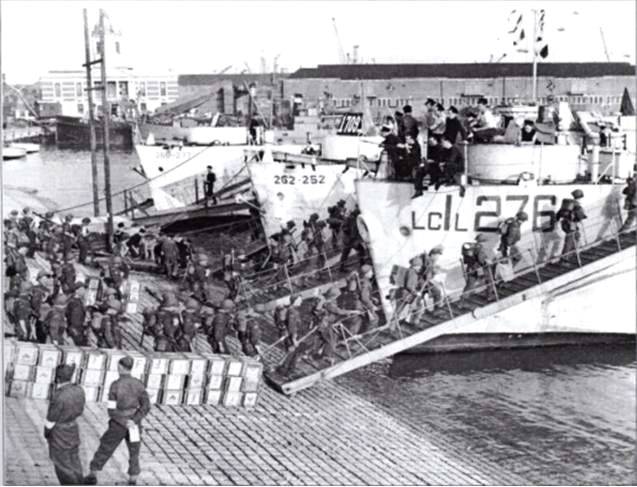

Left:
The H.L.I. of C. load onto Landing Craft, Infantry, Large at
Southhampton, 4 June 1944.
Right: Camouflage netting conceals the contents of these
landing craft in Southampton harbour.
4 June
0300 hours
"This is definitely the
real thing" Heavily burdened with equipment, they moved to the
nearby port of Southampton. A rifleman's battle load was
crushing. In addition to weapons and ammunition there were
rations, shovels, picks, personal gear, and even extra rounds
for the two-inch mortars. Magazines for the Bren machmeguns were
spread out amongst all. They also carried bicycles to take
ashore, which would be used to keep up with the mechanized
units.
5 June
The following day arrived
with renewed assurance from the officers that they were going to
invade.
Between 1300 and 1400 hours, the Highland Light Infantry of
Canada's flotilla of four Landing Craft, Infantry, Large and a
special craft for the Bren carriers slipped away from the
harbour quietly with no fanfare with the exception of a few dock
workers waving them off; while one of the pipers played "Road
to the Isles."

Mealtime for infantrymen of the Highland Light Infantry of Canada
(with bikes)
on board a landing craft, en route to France on D-Day.
D Day
6 June, 1944 0400 hours
The inky blackness
shrouding the English Channel erupts with light and thunder as
the invasion fire plan initiates with a massive naval shelling.
Fighter-bombers are on their way by first light and this
combination amounts to a preparatory bombardment the likes of
which history has never before witnessed. From the decks of
their landing craft, officers had a grandstand view of the
fireworks, their confidence boosted by such a display of
firepower.

The H.L.I. of C. at Bernières Sur-Mer, disembarking with their
bicycles
The H.L.I, with 9th.
Brigade, was supposed to land on code name Nan Red beach right
behind the first wave of attackers, but instead were redirected
to Nan White after chugging in circles for hours. White beach
was the town of Bernières- sur-Mer, and on this beach the H.L.I
arrived late in the morning, just after 1100 hours.
The Queen's Own Rifles from Toronto had captured this beach at a
loss of over 100 casualties. As the HLI's craft approached,
bodies of dead Q.O.R.'s bounced and skidded along the hulls, but the
invaders could not pause to pick up the dead. Two sailors of
each landing craft jumped down into the corpse strewn water and
waded to the shore, holding on to separate ropes so that their
craft may be steadied for disembarkation. With that done, the
troops grabbed their bikes off the decks and descended into some
four to five feet of water.
Gathering in Bernières, the H.L.I expected to mount their bicycles
and follow behind a rapid advance of tanks and mounted infantry.
But instead, they spread out and waited while the tanks
attempted to knock out hidden field guns which had already hit
three of their own M-10 self propelled guns. Meanwhile, the
citizens of Bernières were out of their homes, thanking soldiers
with offerings of wine and milk.
It was late in the afternoon when the advance got under way, and
the H.L.I mounted their bikes and headed for Form Up Point Elder,
which was in fact the village of BenySur-Mer, arriving by 1915
hours.
Moving as fast as they dared, all Canadian units pressed towards
their D Day objective, Carpiquet airfield. The North Nova Scotia
Highlanders and tanks of the Sherbrooke Fusiliers led the way for
the 9th "Highland Brigade", clearing out pockets of
resistance and suffering only a few casualties from constant
mortar tire and sniper's bullets.
3. Le Buissance and Bloody Buron
8 June-8 July 1944
Hell's Corners is just down the road After the catastrophic
ambush on D Day plus-one, which saw the North Novas and
Sherbrooke Fusiliers suffer the loss of nearly half their men
and tanks, the 9th Brigade holed up the twin villages of Le
Buissance and Villons le Buissance. The HLI's allotted position
would face the town of Buron, and it became clear that
eventually they would come to terms with the enemy there;
however the more immediate task was to dig in while Pioneer
Platoon was set to work clearing their surroundings of mines.
Padre Jock Anderson received his initiation of combat at Le
Buissance as much as any rifleman. For him, it meant a body
wrapped in a blanket and a standard military burial, after which
the corpse is lowered into a temporary three-foot grave,
adequately marked to facilitate recovery later.
The tragedy of Caen
By 2200 hours, the city of Caen's north end was being
obliterated by Lancaster heavy bombers, killing hundreds of
French citizens and very few German soldiers. The reasons for
doing this would be defended by the Generals for years after,
but it was clear for those who witnessed the aftermath that the
bombing of Caen was nothing short of criminal.
From their slit trenches, any Canadian, British or German
soldier could see the monumental firestorm consuming the ancient
city. Airplanes continued to drop bombs well after Caen was
surely already flattened. The resonant vibrations from these
explosions traveled through the ground and under the feet of
soldiers, as bits of dirt dislodged from the trench walls and
cascaded onto army boots before settling on the earthen floor.
8 July
Morning, just before 0500, every soldier was in a two man slit
trench, waiting for the guns to open up and the order to move to
the assembly area. In these trenches, they squatted down on
their haunches or sat with their knees tucked in on the dirt
floor. It was uncomfortable to stand when loaded down with Bren
magazines, hand grenades, hanging bandoliers and shovels. The
combined weight pulled at the shoulders and dug into the backs
of necks. It was a last chance for a smoke, even though you
weren't supposed to. You could cover up when lighting it, then
share the cigarette with your trench partner, passing it back
and forth without being seen.
On one knee, the rifle sections waited in arrowhead formations;
just as in training. Last minutes were spent adjusting kit, and
talking to the man to the right and left while section
commanders and platoon sergeants made visits to their men,
reassuring them and inspecting gear. Each NCO and officer also
carried a curette of morphine to administer to the wounded, with
the instructions to write "M" on the casualty so that medics did
not mistake the comatose wounded for dead.
"Now boys, we're gonna charge!"
"C" Company's advance was no less harrowing. When the order to
advance was given, Piper Sagan of the pipes and drums band
defiantly stood up at the very front of the company, clutching
not a weapon, but his beloved bagpipes instead. In amazement,
George Mummery of #13 Platoon watched him breath air into his
instrument, which made a droning sound as he did so. But Piper
Sagan never got a chance to play; George: "he took about two
steps before he got it. " (Sagan survived his
wound and the war, and lived more than 50 years after.)
When George's platoon commander, Lieutenant McCormick, ordered
#13 Platoon to advance, they barely started moving before being
forced to the ground by machinegun fire. Pressing as close to
the earth as possible, streams of bullets could be heard buzzing
inches overtop, like a nest of angry hornets. Eager to push
forward, McCormick rose up from the ground and called out to his
platoon, "Now boys, we're gonna charge! "
In disbelief the platoon just watched him as he tried to coerce
his men onto their feet; bullets hit the spade of his shovel
with a pang beside his head, and while he called out, George
Mummery saw him shot through his body and both eyes. After he
dropped backwards, lying dead on the ground, the platoon crawled
the distance to Buron. (After the battle, Padre
Jock said "I knew he'd do something like that. ")
Padre Jock Anderson was still at work. Even when all of the
wounded were evacuated to the advance aid station, he had the
task of collecting the dead. He and his driver, Albert Mitchell
of Galt, used standard issue military grey blankets to wrap the
bodies in, picking them up from the collection of corpses and
carefully preparing them for a standard military burial under
the cover of an apple orchard. Each body was a man Jock had
known, had spoken to, had offered encouragement to when they
confessed their fears.
"Every man has his breaking point, " Jock said, recollecting the
terrible task which haunted him for the rest of his life.
He began to feel annoyance with Mitch, who was a furniture
upholsterer in Galt. It seemed as though he was applying his old
trade as he carefully wrapped each corpse into a neat and proper
package.
"MITCH, can't you work any. faster?" Jock snapped. Without
looking up from his work, Private Albert Mitchell responded to
the padre, "They gave their lives and now this is the least I
can do. "
Jock felt ashamed and fell silent as he worked for the rest of
the time until they ran out of blankets. He drove on his own
back to the rear echelon to get more, but they were also out; so
he drove onwards to 3rd Division's facility. It was there he
became furious with an ignorant store-man:
"The store-man says to me, 'you've had enough blankets already,'
that's when I started to become upset, I was yelling and I broke
down and started to cry. "
The colonel commanding the facility had Jock put under with a
sedative, and hours later he woke up laying on a stretcher,
wrapped in a blanket with a medic's tag attached which read:
"Battle fatigue. Return to England. "
Jock sat up, ripped the tag off, and stood up. Shaking off the
effects of the sedative, he left the aid station and managed to
return to the H.L.I within the hour.
When Lt. Campbell and Major Edwards arrived for orders, it was
approaching 0200 hours. No one had slept for almost 24 hours and
hadn't slept properly for more than that. Geordie Edwards was
both furious and grief stricken. He had been left behind as an
LOB and let his colleagues go without him into a meat grinder
until Smokey Griffiths was wounded, after which Geordie took
command. When Brigadier Cunningham told the assembled officers
that they would not stop before going into Caen, Major Edwards
became outraged, as well were the other battalion commanders.
Chuck Campbell:
"They said, 'we're going into Caen ', and he (Edwards) said,
'With what? We don't have anyone left! "'
No one was the same after Buron. They would forever after belong
to a class of humans separate from the rest of society; those
who would be spared the horror of battle could never be expected
to understand. But the war would not stop for them on this day
to mourn the loss of comrades; not even a brief ceremony to
recognize what had happened on the 8"' of July, 1944 to the
Highland Light Infantry of Canada. No matter how justified the
war was, there could never be glory in it; even when every man
fought so heroically. It was simply a terrible job which had to
be done because there was no other choice.
Sixty two dead and 262 wounded (many of whom would later die),
which left roughly half of them standing. Like the thousands of
other battles that took place in Europe, Buron was the epitome
of war; and when it ended there was nothing but the living
history, told by survivors. As the troops marched on to Caen,
they left behind an orchard filled with rows of rifles stuck
bayonet first into freshly churned earth, crowned with a dead
man's helmet.
With rifles slung they marched down the road like zombies and
eventually one could not look back to see Buron anymore. For the
ragged survivors, it became merely a memory; a window of time
and space to peer into a piece of man made hell which tore an
enormous empty void in the soul.

Private R.O. Potter of The Highland Light Infantry of Canada
repairing his bicycle, France, 20 June 1944.
4. The Cost of Liberation
More than 24 hours of hellish combat had gone by, and sleep was
the only thing any soldier wanted. But instead, after scarcely
having enough time to bury their dead comrades, the H.L.I were
given marching orders; Caen was to be occupied by nightfall.
While reconnaissance units probed forward, the weary H.L.I
formed up by company, filing on both sides of the road. There
was no need to spread out in the fields in arrowhead formation,
the North Novas had bounded past them right after the capture of
Buron, which had made them subject to the same intense shelling
for most of their advance into Franqueville. Snipers, machinegun
posts and mines were hampering advances by the 9th Brigade,
which was led by the S.D.G.'s, who had captured Authie the day
before with considerably light resistance offered.
As they entered what was left of Caen, it became obvious that
the soldiers who fought were not the only ones suffering. Two
nights previous they had heard and seen the bombardment of the
ancient city, it was presumed that at least German army
formations were being targeted. But this was no surgical
operation. Caen was simply carpet bombed, and soon they realized
that virtually no Germans were in the city itself, just innocent
civilians.
Caen was reduced to a heap of smoldering rubble, with the living
French civilians trying to rescue people trapped in collapsed
buildings, pick up the dead, and salvage what they could. With
their homes destroyed, they were now refugees in their own city.
A citizen of Caen described seeing the first allied troops
arrive:
"At 2:30 p.m., at last, the first Canadians reached the Place
Fontette, advancing as skirmishers, hugging the walls, rifles
and Tommy guns at the ready. All Caen was in the streets to
greet them. These are the Canadians, of all the allies the
closest to us ... the joy is great and yet restrained, people
forget the Calvary that we have been undergoing since the sixth
of June. "
"Flowers and good wishes strewn everywhere, " the H.L.I War
Diary states, "these people were really pleased to see us. "
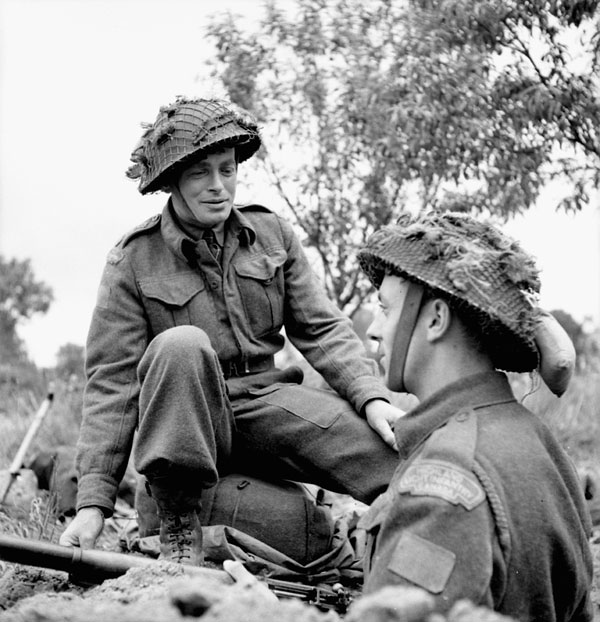
H/Captain John M. Anderson, Chaplain of the Highland Light
Infantry of Canada, talking with Private Lawrence Herbert in his
trench near Caen, France, 15 July 1944.
14-16 July
After marching to the north end of Caen and once again occupying
the grounds of a seminary, the H.L.I was given 48 hours rest, as
was the entire 3rd Division. The Canadian 2nd Division had
landed and now took over the front lines so that the 3rd could
lick its wounds.
Hot showers and a new change of underwear and socks were
gratefully received; the old ones being tossed into one large
hole and burned! Under a brilliant hot sun, they washed the rest
of their clothes, and while these dried on improvised clothes
lines, laid down for precious undisturbed sleep. After a hot
meal the troops were treated to movies under a canvas tent,
courtesy of the Salvation Army, and even an issue of beer and
liquor. Being as it was the first official issue of alcohol, it
meant the troops had not officially dabbled in the local cider,
calvados.
The battle for Caen continues "At 0410 hrs we were in position
at MR (Map reference) 069715. The brigade and supporting arms
lined the west bank of the river ORNE and dug slits in its ant
infested soil. At 0540 our morale was raised by one of the
greatest air assaults of this war 1000 Lancasters
commenced dropping them on VAUCELLE. At 0645 hrs. the medium
bombers started their attack on the enemy gun area. " - War
Diary.
0820 hours
With other units leading the attack, the H LI's crossing of the
Orne River at 0820 hours was uneventful, walking over a double
"Bailey Bridge" dubbed "Winston" and "Churchill" by the British
engineers who constructed it. After crossing, they turned south
towards the industrial sector of Caen known as Faubourge de
Vaucelle. On their left, as they walked, was the impressive
sight of dozens of tattered glider aircraft which marked where
the British 6th Airborne Division had landed the night before D
Day.

The pipe Band playing in battledress after the liberation of
Caen, France 1944
20 July
As they approached the fortress of Boulogne, resistance was
expected at some point, it was just a matter of where and when.
Earlier that day, the North Novas came under machinegun fire
from a road block not far from the HLI.
Leaving the town of Samer gave way to more beautiful French
coastal countryside; to their front, a bank of sand dunes
straddling the road came into view as they advanced.
It is possible they heard it first; a muffled concussion sound,
like a car door being slammed in the distance, thunk. If so,
there may have been a momentary pause before reacting to the
unmistakable sound of an eight centimetre mortar tiring. From
this distance, the flight time could be greater than ten seconds
before the first round hit; but the enemy machineguns would open
up the moment their quarry started to take defensive measures
against an ambush. The bulk of the section was able to take
cover in the ditch on their side of the road, but on the other
side, Cpl. Banks and Major Sim were hit almost immediately.
Both bodies of Major Sim and Cpl. Banks were on the opposite
side of a road raked by fire, there was no chance of extricating
them until the enemy were dealt with.
When Doug Barrie's team had arrived with the trapped section,
but not the two casualties, Padre Jock Anderson decided to mount
a Bren carrier himself, bringing with him a large Red Cross flag
which was prominently displayed as they drove to the scene of
the ambush. Although the Geneva Convention prohibits firing at
the Red Cross, the padre came under fire and had to retreat
empty handed.
Night patrol
That night, The Regiment spread out into an all around defence,
each company using what cover was available; a patch of bush, a
portion of high ground, or sometimes the ditch along the side of
the road would have to do.
Mist Covered Mountains
7 September
Although Major Gord Sim's body was recovered by a patrol, Cpl.
Banks body had to be dropped when hidden enemy began firing on
them.
It was getting late in the day, but an early summer evening
provided enough light for the burial party. From the safety of
the battalion's perimeter they set off with the body of Major
Sim to a church cemetery in a nearby village named Condette.
Captain Jock Anderson had selected this spot from his map, and
in the empty village the jeep parked, after which the funeral
party unloaded the body, which was neatly wrapped in a standard
grey military blanket on a stretcher. Through a typical high old
wall surrounding the church grounds the small procession made
their way; there was Jock, Doug Barrie, a piper and four
soldiers carrying the stretcher as pallbearers.
By the ancient wall a spot was picked to dig, and it was quiet
as they did so, just the sound of shovels churning the earth.
Then, Simmy's body was carefully lowered into the shallow grave
dug to military standards, to facilitated later recovery, and
Jock completed the service. The piper then played a lament which
echoed beyond the church grounds and the empty village, while
the burial party listened in silence. Long shadows of a late
summer day cast over old gravestones, and a newly placed wooden
cross. The tune was called Mist Covered Mountains; it was the
fulfillment of a request Gord had made to Jock:
"...he said, `I'm either going to get the Victoria Cross or I'm
going to die; and I think I'm going to die. So when they bury
me, I'd like them to play Mist Covered Mountains. "'
"I marked it on the map where he was buried, " Jock explained,
"and showed it to the CO ... and he says, `Padre! What are you
doing? We haven't cleared that place yet!"'
It is a depressing affair that the body of Cpl. Banks was left
behind as the HLI moved to new positions in the forests
surrounding Mont Lambert, just outside of Boulogne. The S.D.G.s,
who took over in this area, reported the Free French spotted
Germans in the cover of night booby trapping his body; a common
practice.

3rd. Div. infantry in action. There are less soldiers
wearing the D Day "Turtle” helmets in late war pictures of 3rd.
Division.
The others, wearing regular "Tommy" helmets, are replacements.
General Simonds plans Operation Wellhit; (the
capture of Boulogne)
Canadian Operation Wellhit was dubbed and preparations began in
the beginning of the month of September. Its objective was to
capture of the coastal city of Boulogne using 3rd Division,
after which the allies would use its port immediately, as the
flow of supplies from Normandy was too slow.
By 8 September, Medium bombers were dropping their payloads onto
Boulogne, even though the civilian population was for the most
part still in the area. It was, like the bombing of Caen, not
the precursor to a large scale attack either (although
Montgomery and Eisenhower had wanted the attack to go in by this
date), it was instead all part of another meticulous plan
created by Canadian General Simonds (who was a protege of
Montgomery). These plans were the product of his retreats to his
caravan and chain smoking until a solution was formulated and
orders written. Like the numerous failed attacks in the Normandy
and Falaise region, Simonds was heavily criticized for again
taking too long to send his troops in.
Meanwhile, the HLI had opportunity to rest under the cover of
the Foret de Boulogne. Although they altered their positions
several times to accommodate the massing of 3~d Division, their
stay was comfortable enough. The Salvation Army, (or "Sally
Anne") set up a movie screen and projector in a local school
(formerly used as a German headquarters) for the troop's
pleasure, inside of which many of them had sleeping quarters;
"This place is just like a hotel, " a soldier commented. The
glorious rest went on for over a week, which served opportunity
to write letters, sleep and even 72hour leave passes were
allowed in small numbers, (the leave centre was a hotel complex
on the Normandy coast, several hours drive from the Boulogne
area).
Cap Gris Nez
"We were later warned to be ready to move by 0900 hrs of the
24th to the CAP GRIZ NEZ area, " the War Diary records,
"Preparations were set in motion and the battalion again settled
in for the night. The following day's march in the pouring rain
was described as "extremely miserable " as they arrived and set
about occupying the local area.
Their task here was to capture the huge coastal guns which
existed on Gris Nez (which translates to "Big Nose"), a large
outcropping of land which the Germans built giant guns on to
interdict allied shipping and to harass the port of Dover.
Described later as "skilful and inexpensive" the capture of Cap
Gris Nez was necessary to clear the way for shipping traffic.
The HLI honoured the town of Dover, England, by having the
captured Nazi standard and sword of the Gris Nez battery sent to
them as a gift "... in appreciation of the way they stood up
under four years of shelling from these huge guns. "
Rest and Relaxation
The following few days were invested in rest and relaxation for
the troops. Seventy two-hour leave passed were granted to go to
the leave centre, and trips to the Vimy Ridge memorial took
place. Bill Marshall was greeted back by peers who were curious
to know how the social scene in England's hot spots was:
"England is apparently still the same although there is a
shortage of Canadians according to the London girls.
"The Vimy trip turned out to be a real drunk-fest," Charlie
Bradley wrote, "It was a real blow-out that night. It was pretty
lonely for the truck drivers, going back; most of the outfit was
asleep in the back of the truck. The guys who had to stay behind
must have had a hell of a time unloading the guys. Did we ever
feel bad the next day! "

H.L.I. troops wait for the order to advance somewhere near
Breskens, Holland.
6. The Scheldt and The Waal Flats
The Dutch port of Antwerp was North West Europe's largest, and
had been in allied hands since early September. However, the
entrance to this port was an estuary known as The Scheldt.
Without its capture, Antwerp could not be used.
The estuary's defence consisted of one fortress on Walcheren
Island, and another on the mainland at Breskens. It was the
mainland which would be the concern of 9th Brigade. Peter Dewind;
Dutch Underground hero Thanks to an extremely brave and strong
Dutch Underground fighter named Peter Dewind, the 9th Brigade
received invaluable intelligence which they would exploit to
full advantage.
8 October
Loaded 20 men per Buffalo, the battalion marshalled a column of
some two dozen carriers at an assembly area just east of the
coastal town of Oostakker. From here, under the cover of
darkness, they were to enter the water and float down the
winding Terneuzen Canal, arrive at Terneuzen, then get up on and
cross a small portion of land which would technically be the
start line. From there, dip back into the water, spread out into
assault formations and cross the narrow Channel before hitting
the beach.
All
this was to occur without the Germans knowing.

The Buffalo amphibious carrier was indispensable for the
infantry dealing with the massive flooding across Holland.
A Bren carrier could fit perfectly squeezed into the Buffalo's
hold.
Rest and Relaxation in Ghent 4 November
The War Diary:
"Bn. H.Q, Savan St. Ghent. 4-Nov-44 ... Ghent gave the 3th Div a
great welcome -flowers, fruit, etc. The entire division is
billeted in the city. Great kindness has been shown by the
people of the city. " Four days of glorious rest lay ahead for
the battalion, as well as for all of 3rd Division. Field
Marshall Montgomery arrived and all regiments provided
representatives to receive praise.
Ghent was as close to a holiday as could be expected under the
circumstances. Both the officers and sergeants held separate
dances, accompanied by civilians and nurses. The War Diary:
"Conduct of the troops is excellent... The odd `rear area
warrior' has been straightened out on a few details regarding
life at the front but nothing violent has occurred. It is hard
to credit but each man has a better billet than the other. This
is tribute to the hospitality of GHENT. " But by 9 November, the
R&R was over and it was time to get back to the war. The War
Diary:
"Morale is a notch lower than during our stay in GHENT. It is
hard to be dragged from riches to rags in so short a time. "

"B" Company, H.L. I. of Canada Universal Carrier,
Speldrop, Germany, 24 March 1945. (L-R): Company Sergeant-Major
R.E. Bryant, Private L.J. Mullin and Private T.C. Galbraith.
The Waal Flats November 1944-February 1945
One hundred and twenty five miles from Ghent, the H.L.I
travelled to the Dutch-German border by November 11th, relieving
the American 3rd Battalion of the 505 th. Parachute Infantry.
Through Antwerp's underground tunnel and then through Eindhoven,
the road move by vehicle went smoothly, perhaps even more so for
the H.L.I than with other units since the H.L.I used their
wireless sets, not having been informed, apparently, that the
9th. Brigade was to move under strict radio silence.
On a ridge between Nijmegen and Arnhem they took up positions,
once again in the cold, wet earth. Living quarters were dug into
the ground, like badgers or moles, and torn portions of nylon
fabric (from the derelict gliders of the American airborne)
provided a roof for the dugouts.
Mine tape was strung out between positions, white fabric strands
sagging slightly at waist level between six-foot pickets. These
strands marked gaps where soldiers could safely travel. The
Americans before had laid mines all around without marking the
fields, so engineers had to clear many mines to avoid a
senseless casualty. At night, soldiers on sentry would walk
carefully, one hand tracking along the length of tape as they
went; stepping on an allied mine would be a lousy way to finish
the war.
To their front was a depressing no man's land of shell craters
and water, the derelict gliders interspersed throughout this
landscape, as well as the odd war-torn house or barn.
The months in The Waal Flats were to be a tedious, cold, and
miserable experience. No advances would be made by the Highland
Brigade until the new offensive in February.
Not all of the time was spent in the frozen earth of the exposed
Waal Flats. There were rotations of battalions over weeks to
occupy each other's positions, some of which were more
comfortable than others. One battalion in the 3rd Division at a
time would be held back for rest and retraining, and to serve as
divisional reserve. An institution in Nijmegen served as the
rest area, where movies put on by the Sally Anne and better food
existed. However, much of the Dutch population was starving.
Charles Bradley:
"There wasn't much food for the Dutch people. The kids used to
come around at meal time and beg for food, carrying little pots.
If there was any food left in the cooker, they would get fed. "
First Canadian Regiment to cross the Rhine
The Regiment had moved back to the Reichswald Forest area near
the city of Cleve and was static after the battle for the
Hammerbruck Feature. Troops dug in with the rest of the 3rd
Division, short leave passes were allowed for men to go back to
Nijmegen. The rest in Cleve was enhanced by the presence of the
Salvation Army, who, being ubiquitously equipped with movie
projectors and reels of movies, would set up a tarpaulin tent
(dubbed "The Highland Hut" by its 9th Brigade patrons) while
sporadic incoming artillery fire let everyone present know there
was still fight left in the Germans.
There was a training syllabus to prepare for the next operation,
the crossing of the Rhine; where fanatical resistance was
expected. Range work with the various weapons was conducted, as
well as house clearing drill practiced in the ruins of Cleve
(the city was for the most part demolished). Retraining was
important even for the experienced men, but the green
replacements would need it the most; by this time, soldiers
who had been in the war since D Day were the minority.
As the leadership were issued orders, new maps of the Arnhem and
Wesel areas, as well as various air photos, the allied intent
for the massive assault across the Rhine could be appreciated.
The Americans would cross on the south (right) end, the British
on the north (left), while the Canadian 1St Army had a breakout
role. But the 3rd Canadian Division was lent to the British to
beef up their attack. For the H.L.I, they would go in with the
Scottish 154th Brigade which consisted of 1st and 7th Black
Watch Battalions and 7th Argyll and Sutherland Highlanders. As
part of the 51St Highland Division, this army of Highlanders
were tasked with establishing a bridgehead on the German side of
the Rhine; the villages of Speldrop and Bienen among the initial
objectives. The H.L.I of C would be the first Canadian unit
across the Rhine.
Speldrop Farm 24 March
At 1730 the H.L.I went in full force; each company taking a
sector of the village.

Officers of the H.L.I. of Canada at the Rhine River crossing,
Speldrop, 24 March 1945.
(L-R): Captain J.A. Ferguson, Lieutenant
E.R. Isnor, Captain D.A. Pearce
Wasp flame carriers moved up and began burning buildings to "A"
Company's front. The night glowed furiously as the tiny village
of Speldrop burned. It began to rain as the battalion was
relieved to pick up its dead and wounded, and the Scottish
carried on the advance. The battle of Speldrop Farm had cost
approximately 13 dead and 23 wounded
War Correspondent Douglas Amaron of the Canadian
Press submitted this article on 28 May:
"The H.L.I. was the first Canadian formation over the river and
the advance party crossed about 90 minutes after the first wave
of Scottish troops. `it was just an ordinary sail, 'said Capt.
Jack Ferguson, of Galt, Ont., support company commander. The
first attack made by the Galt unit was against Speldrop, two
miles north of Rees, where two previous assaults by Scottish
troops were beaten back, Speldrop's widely separated farmhouses
provided the Germans with wide fields of fire and they had the
approaches to the village covered with self-propelled guns. The
Highlanders, who took 65 prisoners in this village, also
relieved two platoons of the Scottish Black Watch, who had been
sheltering in the cellars. "
Bienen
Only hours later, the HLI received instruction to go in the town
of Bienen, where a repeat of the same situation was occurring.
The Argyll battalion had gone in and been counter-attacked in
the same fashion as the Black Watch in Speldrop; this time the
North Nova Scotians came to their aid, but the fighting was so
heavy they could not complete the capture of Bienen, therefore
the H.L.I was tasked to force out the last fanatical defenders.
The evening was spent fighting through this town, and by the
time they had forced out or killed the last of Bienen's
defenders, The Regiment halted at its outskirts and was again
relieved to pick up more of its casualties.

Dutch women (one
wearing national costume)
and child watch of the H.L.I. of Canada's "C" Coy.
passing through Dalfsen, The Netherlands, on 13 April 1945.
The HLI of'C 1940-45 describes the final stages
of the HLI's last battle on 7 April, in the town of Zutphen:
"In many cases the enemy groups would lie low while house
clearing parties passed through or else infiltrated back in the
darkness. In such a manner the battalion command post was cut
off and surrounded by enemy for a time during the night. It was
an uncomfortable situation, for the commanding officer and his
staff as they were not able to make a move without drawing fire
from machine guns and panzerfausts stationed in nearby windows.
However, this situation was rectified when several parties
arrived from the forward companies and the street was again
cleared after some confused fighting. "
After this
fighting, the regiment moved up north to Friesland, to liberate
Leeuwarden and after this they also liberated Harlingen and then moved on to the "Afsluitdijk"
to inspect the fortifications on it and disarm the German
prisoners there, and they also made them clear their own mine fields.


Infantrymen of “B” Company, HLI of Canada, examining a German
“dragon’s teeth” barrier near the Afsluitdijk across the
Zuiderzee, Netherlands, 19 April 1945. (L-R): Lance-Corporal W.J.
King, Privates J.A. Carr and W.G. Scott
April 15, 1945
Leeuwarden,
Leeuwarden, the Capital of Friesland, was liberated by the Third
Canadian Infantry Division. The next day a Civic Reception,
Liberation Parade and Concert on the “Nieuwe Stad” in town was
organized where the combined Pipe Bands of the H.L.I. of Canada
and the North Nova Scotia Highlanders played.

The combined
Pipe bands of The Highland Light Infantry of Canada and The
North Nova Scotia Highlanders arriving at the civic reception
Leeuwarden, Netherlands, 16 April 1945.

... on to the
Concert on the “Nieuwe Stad”
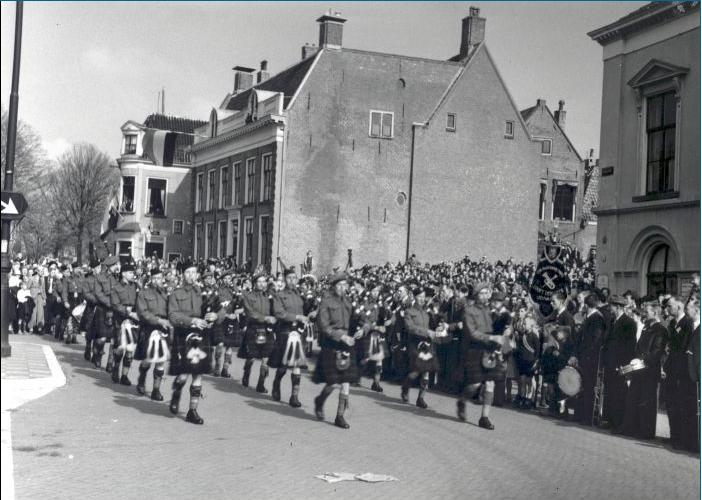
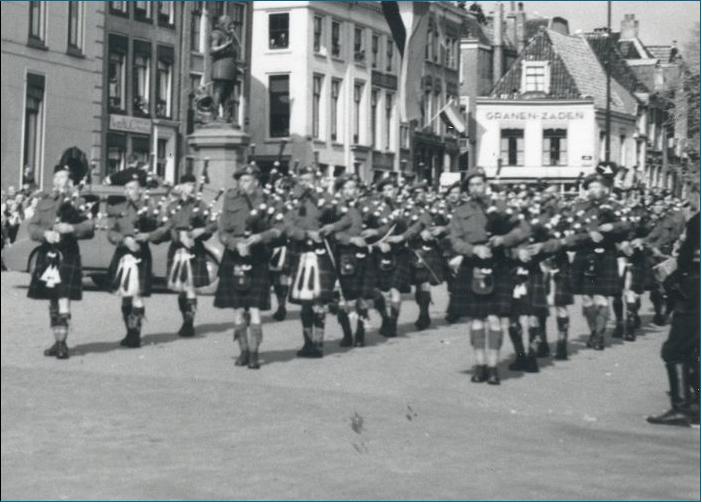
... where some clever countering was to be exercised
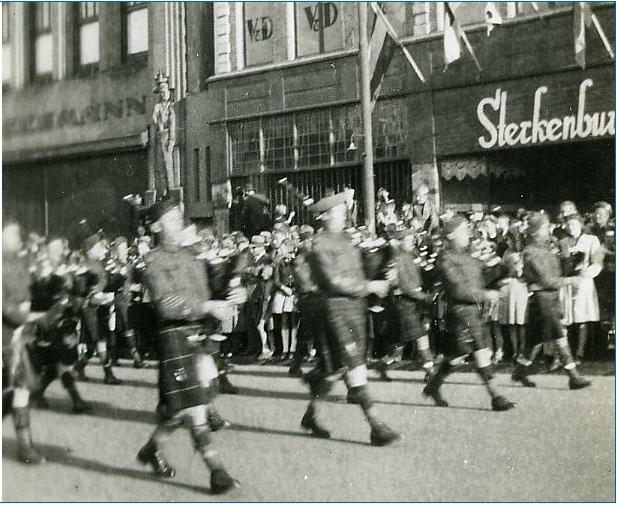
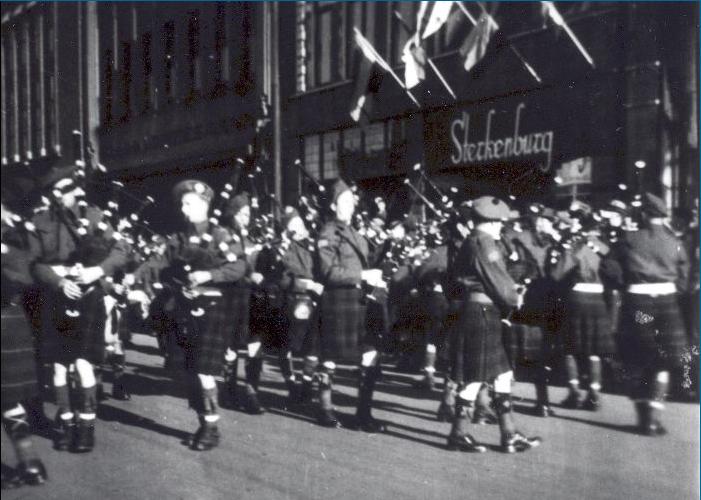


They were to return
to Leeuwarden a month later, on May 13, for a Thanksgiving
Service in the “Grote Kerk”.

... on the
Zuiderplein: parade and march through town afterwards.

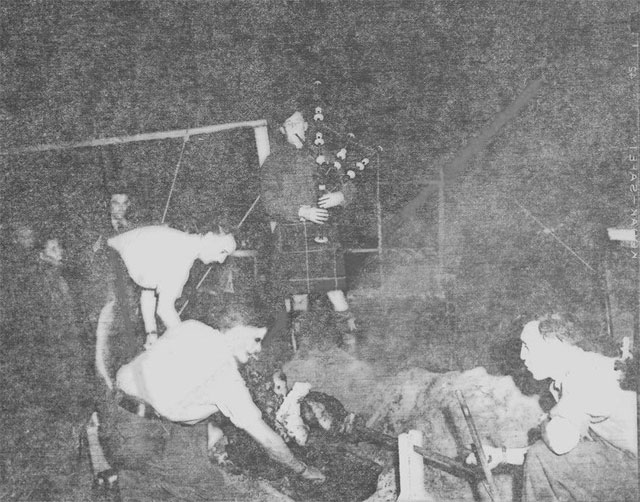
The Duch civilians always had a great liking for the stirring
sound of the bagpipes, and with the war
over, a good Bar-B-Q was always enjoyed together
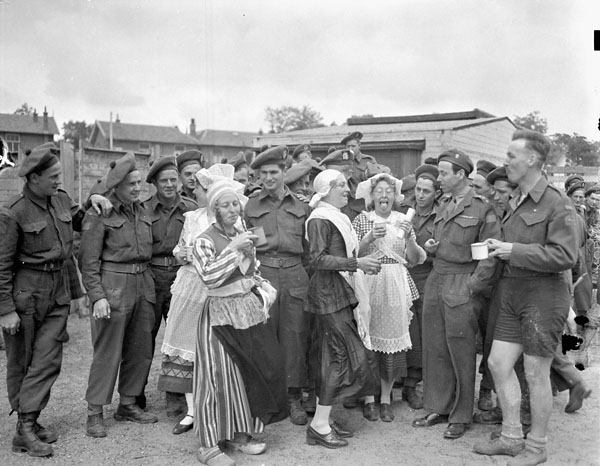
as were the sports events. Dutch women (in
regional traditional dress) having tea with personnel of
the 3rd Canadian Infantry Division during the Division’s Sports
Day, Hilversum, Netherlands, 14 June 1945

This is what the H.L.I. of
Canada's collar badges looked like

Cambridge Armoury, Ainslie Street South, Galt, home of The Royal
Highland Fusiliers of Canada. They originated in Berlin, Ontario
on 14 September 1866 as the 29th Waterloo Battalion of Infantry.
It was redesignated the 29th Waterloo Regiment on 8 May 1900,
then the 29th Regiment (Highland Light Infantry of Canada) on 15
April 1915, The Highland Light Infantry of Canada on 29 March
1920 the 2nd (Reserve) Battalion, The Highland Light Infantry of
Canada on 7 November 1940 and then The Highland Light Infantry
of Canada on 1 May 1946. On 1 October 1954, The HLI of C was
amalgamated with The Perth Regiment and renamed The Perth and
Waterloo Regiment (Highland Light Infantry of Canada). On 1
April 1957, the two regiments ceased to be amalgamated and
resumed their former designations. On 26 February 1965, it was
amalgamated with The Scots Fusiliers of Canada and redesignated
as The Highland Fusiliers of Canada'. The Regiment assumed the
appellation "Royal" to become The Royal Highland Fusiliers of
Canada on 7 July 1998.

This is a photograph of the Journal of Captain George Pollard,
as written
during his time in the H.L.I. of Canada.
This photograph and the following photographs, are used by
courtesy of
John Smith (a grandson of George Pollard) who created the page
http://georgepollard.ca/
with the intention of preserving and sharing Captain Pollard's
first-hand experiences from WWII, as written down day by day in
his own journal, which can be found on that webpage, together
with many interesting photographs taken during his time in the
H.L.I. of Canada.
Captain Pollard rose, by a number of trainings, from soldier to
Captain and Padre, and so finally became a colleague of Captain
and Padre Anderson of the H.L.I. of Canada.

This is a photograph
of
Mel
Quick and Sylvia Trickey on the Bognor Regis Baptist Church
steps, after their wedding on November 25th, 1942.

George Pollard en
route in Holland, 1945

George Pollard in
front of the Officers' Mess somewhere in Holland, 1945
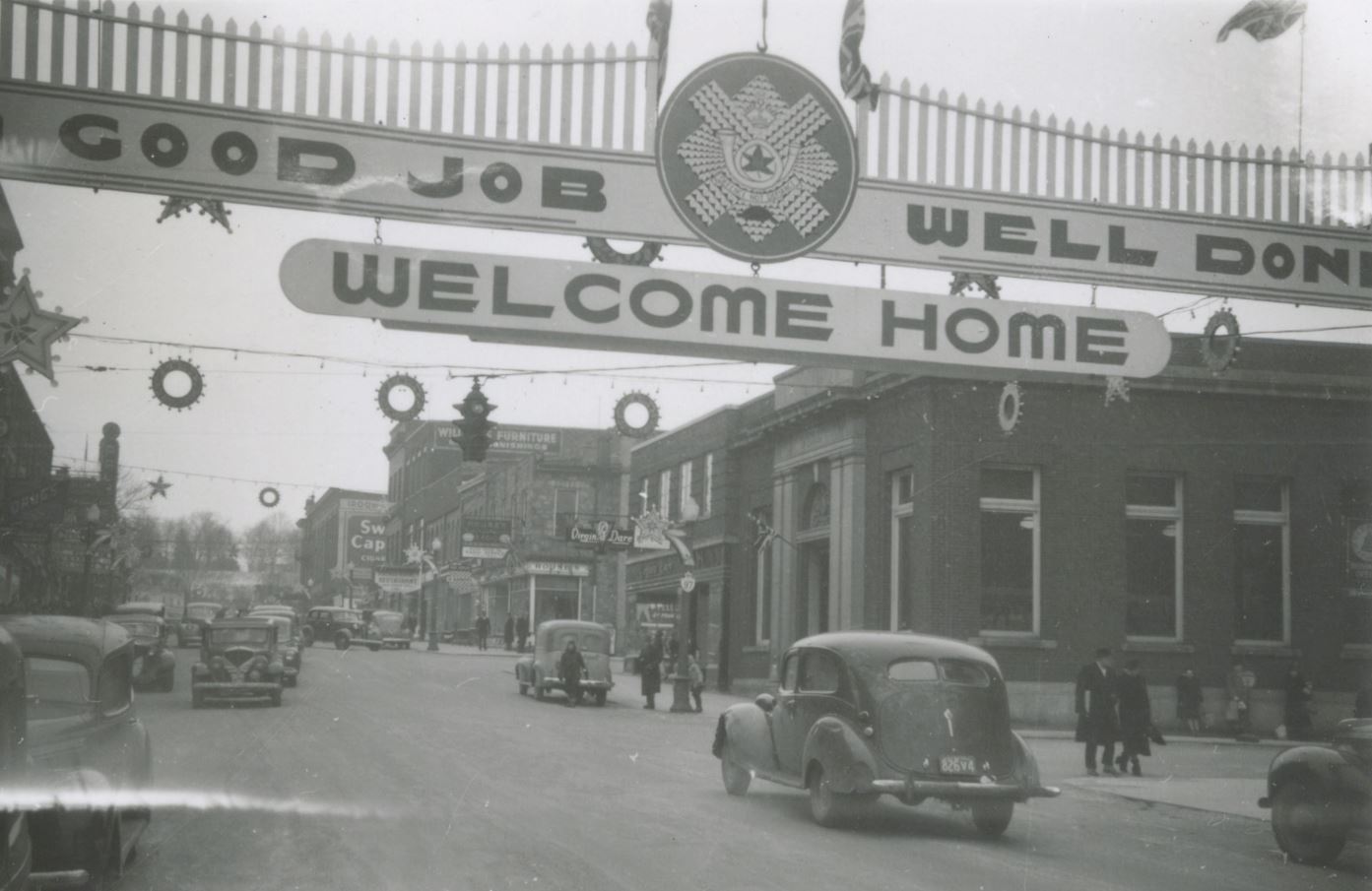
Welcome Home on
return at home in Canada, 1945